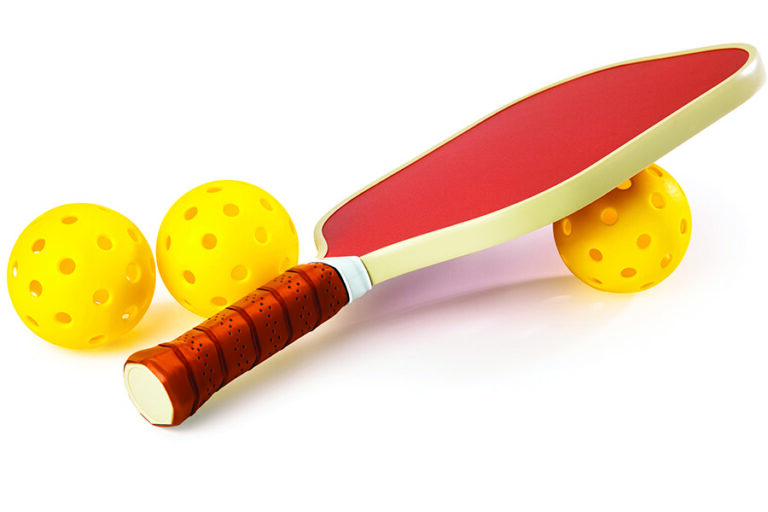Nick Chavis knows all about athletic injuries as a former soccer player at Calvert Hall and UMBC.
That’s one reason he started playing pickleball, a fast-growing sport that’s considered a safer alternative to many others.
Yet even pickleball injuries are not uncommon. The most common types of injuries among pickleball players are rare sprains, strains and fractures and account for 60 percent of all pickleball-related injuries, according to a UBS study. Pickleball injuries may cost Americans $377 million in health care costs this year, the UBS analysis found.
“There is an equalizer to the game that allows young to play with old,” said Chavis, a parisher of St. Leo in Little Italy and a 1996 Calvert Hall alumnus. “I haven’t seen many injuries in the two-plus years I have
been playing.”
Pickleball is a paddle sport that combines elements of tennis, ping pong and badminton. Maryland has 194 pickleball courts, according to Pickleballify.
Upper extremity injuries related to playing the game are evaluated at Towson Orthopaedic Associates weekly, according to Mary Jo Holloran, an adult nurse practitioner at Towson Orthopaedic Associates, part of the University of Maryland St. Joseph Medical Center in Towson.
In a survey of injuries evaluated in U.S. emergency departments from 2010 through 2019, there is a 21.5 percent increase in ER visits for pickleball-related injuries. Most injuries fall into the category of “slip/trip/fall/dive” according to the study published by BMC, a medical research firm.
The most common hip injuries from pickleball are muscle strains of the gluteal, hip flexor or hamstring muscles, according to Dr. Jack Steele, an orthopedic surgeon at Towson Orthopaedic Associates. Labral tears and exacerbation of underlying hip arthritis can also occur.
“Muscle strains are treated with rest, antiinflammatories and physical therapy to work on stretching and strengthening,” Steele said. “Labral tears are often treated non-operatively with anti-inflammatories, physical therapy and sometimes injections. Hip arthritis is treated nonoperatively if mild to moderate, but if it is severe and recalcitrant to non-operative management a hip replacement can be performed. Most patients are able to get back to playing pickleball after a hip replacement.”
These injuries have not stopped people from playing.
“As folks have looked to escape hibernation during and after the pandemic, the popularity of the sport has risen,” Holloran said. “Fifty percent of the current pickleball players are 55 or older. This demographic adds to a rise in pickleball injuries. It is a low-impact exercise that is easy to learn, however, the need for quick movement and agility, as well as balance and strength, can increase possible injury if players are not prepared prior to stepping on the court. Most pickleball injuries occur in the 60- to 79-year groups.”
Acute wrist injuries are the most common complaints. They occur while tripping and reaching with an outstretched hand to break a fall. The wrist injuries that are sustained range from a sprain to a fracture. Colles fracture of the wrist is the most common injury that may sometimes require surgical correction in a pickleball injury.
Other areas of the upper extremity that can be injured by way of a fall include the elbow and shoulder including fracture or tendon tears. A pickleball player can also sustain injury to fingers and hands including sprains, strains and fractures.
“The best way to avoid getting injured is to do lots of stretching of the calf muscles and hamstrings prior to playing pickleball and begin warming up slowly on the court,” said Dr. Jeffrey Brodie, a foot and ankle orthopedic surgeon at Towson Orthopaedic Associates.
Dr. Sarah Hobart, a hip and knee orthopedic surgeon at Towson Orthopaedic Associates, recommends warming up and stretching to avoid injuries. Strengthening thigh muscles – quadriceps and hamstrings – in addition to hip musculature, can also help in the protection of the joint. When returning from an injury, occasionally a brace may be recommended to give the knee additional support and compression to avoid re-injury, she said.
Despite the risks, plenty of people are still playing pickleball.
“What I love about it is that it is a family event for us,” Chavis said. “My 69-year-old parents can play with my 13-year-old son. My wife and I now play as well. We all play pickleball as part of our weekly fitness, too.”
Read More Sports
Copyright © 2023 Catholic Review Media








